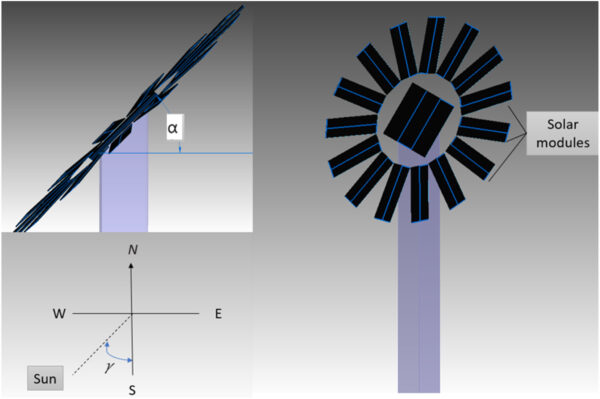A group of scientists from the Hungarian University of Agriculture and Life Sciences designed a prototype of a solar photovoltaic tree that purportedly offers an optimal balance between energy production and thermal management.
The key feature of the system is a larger distance between the solar modules compared to conventional solar tree designs. This approach is intended to reduce shading losses between the panels while improving cooling and heat dissipation.
The prototype has a total diameter of 660 mm and relies on solar modules based on cells provided by Shenzhen Xiangxinrui Solar Energy Co., Ltd. China. Each panel has a size of 180 mm x 60 mm x 3 mm and an efficiency of 22%. The solar tree also relies on a stem measuring 1800 mm in height and a flat wooden sheet segmented into fifteen branches.
In order to validate the proposed design, the scientists compared its performance with that of a flat PV system with the same characteristics. “Both the solar tree and the flat module were integrated and configured within the same electrical circuit, featuring six rings connected in parallel,” the scientists explained. “Each ring consisted of three modules connected in series, resulting in a total of eighteen PV modules.”

Both the solar tree and the flat PV system were tested with a south orientation and tilt angles of 20, 30 and 45 degrees.
The tests revealed that with the 45-degree angle the solar tree recorded a maximum temperature of 49.8 C and the flat system had 38.05 C. As a result, the solar tree configuration yielded a maximum power output of 14.54 W, while the flat system produced 11.8 W.
Under the 30-degree tilt angle configuration, the flat system reached a temperature of 51.3 C and the solar tree reached 40.75 C. The latter achieved a maximum power output of 13.84 W, compared to 11.05 W for the flat system. With the 20-degree tilt angle, the solar tree reached a maximum temperature of 33.95 C and the flat system of 43.86 C. The former produced 14.05 W and the latter 11.4 W.

“Empirical results indicate that the flat PV module’s temperature exceeds the solar tree’s by over 10 C, owing to the less efficient convective heat transfer,” the academics stated, adding that the temperatures of the ground shaded by the solar tree were reduced by 3–7 C compared to the unshaded ground. “The efficiency of the solar module configuration proposed herein witnessed an increment of 16–23 % relative to the flat module.”
The researchers also observed that the solar tree offers a land footprint reduction of 96 % compared with the conventional PV systems.
“An examination of the ground footprint revealed that the sunflower PV module afforded 85 % land savings relative to the flat PV module,” they stated. “The area under the solar PV tree can be used for parking and agriculture purposes.”
Their findings were presented in the study “Sunflower solar tree vs. flat PV module: A comprehensive analysis of performance, efficiency, and land savings in urban solar integration,” published in Results in Engineering.
Researchers from the Korea Maritime Institute recently proposed the use of solar trees to build photovoltaic plants in mountainous forest areas in land-scarce South Korea. They defined the new concept as forest-photovoltaic and explained that it would both maintain carbon absorption activities under the solar trees and produce solar power on the upper part of forest land.
Other researchers from Amity University, Noida, in the Indian state of Uttar Pradesh, recently developed four different designs for solar photovoltaic trees that purportedly require less physical space than conventional PV systems in urban environments.
This content is protected by copyright and may not be reused. If you want to cooperate with us and would like to reuse some of our content, please contact: editors@pv-magazine.com.









By submitting this form you agree to pv magazine using your data for the purposes of publishing your comment.
Your personal data will only be disclosed or otherwise transmitted to third parties for the purposes of spam filtering or if this is necessary for technical maintenance of the website. Any other transfer to third parties will not take place unless this is justified on the basis of applicable data protection regulations or if pv magazine is legally obliged to do so.
You may revoke this consent at any time with effect for the future, in which case your personal data will be deleted immediately. Otherwise, your data will be deleted if pv magazine has processed your request or the purpose of data storage is fulfilled.
Further information on data privacy can be found in our Data Protection Policy.